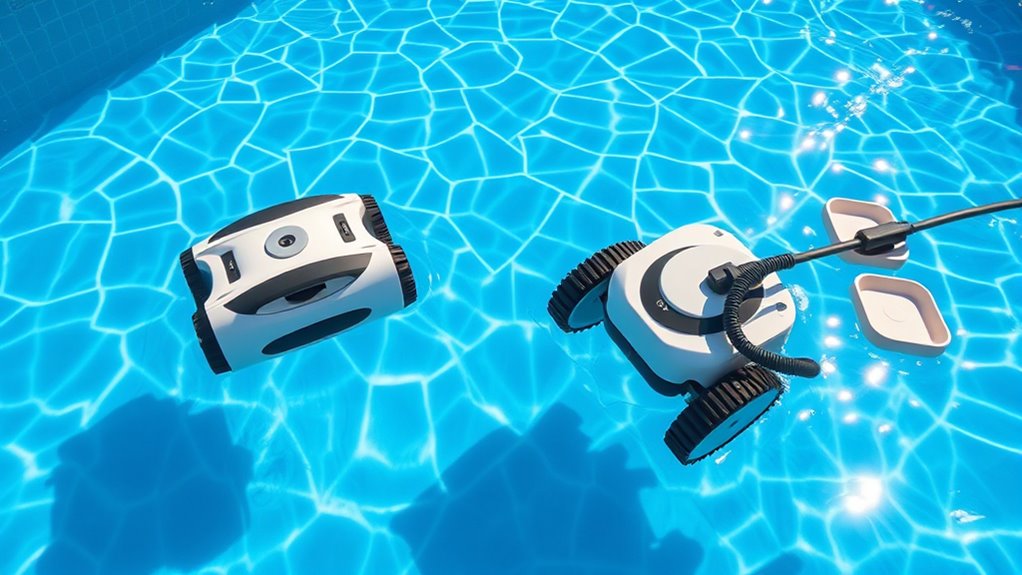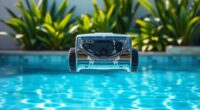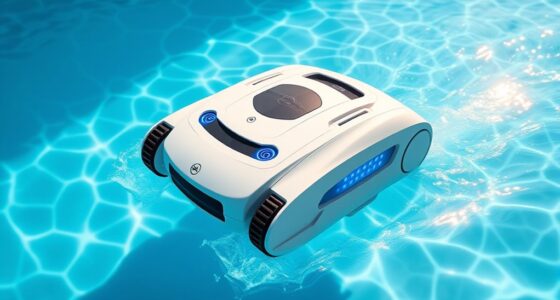Suction pool cleaners are budget-friendly and easy to operate, attaching directly to your pool’s filtration system to handle large debris efficiently. Robotic cleaners cost more upfront but offer better coverage, deep cleaning, and ease of use, working independently with smart navigation. If you want a quick, simple solution for small pools, suction cleaners work well. For larger or complex pools that need thorough cleaning, robotic models are worth considering. Learn more to find the best fit for your needs.
Key Takeaways
- Suction cleaners are budget-friendly and simple to operate, relying on the pool’s filtration system for cleaning.
- Robotic cleaners are more expensive but offer advanced navigation, thorough coverage, and deeper cleaning capabilities.
- Suction cleaners excel at removing large surface debris but may struggle with corners and intricate pool shapes.
- Robotic cleaners provide comprehensive cleaning, including fine particles, corners, and complex pool designs.
- Suction cleaners are ideal for small, straightforward pools, while robotic cleaners suit larger, more complex pools needing detailed cleaning.
How They Operate: Mechanisms and Functionality
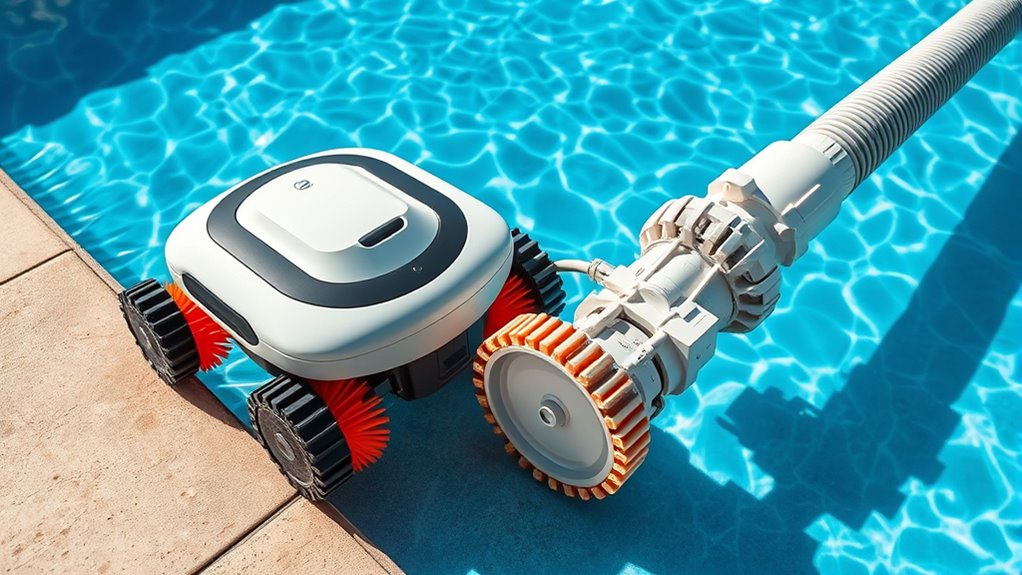
Suction pool cleaners operate by attaching to a skimmer or dedicated suction port, where they rely on the pool’s existing filtration system to power their movement. You control them mainly through manual operation, which involves setting up the cleaner and letting it work without much input. The user interface is straightforward, often consisting of simple hoses or hoses connected to the pump’s suction line. Some models require you to manually position the cleaner and start the system, while others run continuously once attached. These cleaners typically follow a random or programmed pattern, moving across the pool floor and walls. While they depend on your pool’s filtration system, their operation is simple, and they don’t require batteries or additional power sources. Understanding the technology behind pool cleaning devices can help you choose the best option for your needs.
Cost Considerations and Budgeting

When evaluating pool cleaning options, understanding the costs involved can help you make a more informed decision. Pricing strategies vary between suction and robotic cleaners, with upfront costs ranging from affordable to premium models. Robotic cleaners generally have higher initial prices but often include advanced features, while suction models tend to be more budget-friendly. Don’t forget to consider warranty options, which can save you money on repairs and maintenance over time. Some brands offer extended warranties or service plans, adding value and peace of mind. Be sure to compare the total cost of ownership, including replacement parts, filters, and energy consumption. Additionally, analyzing competitor strategies and market positioning can help you select a model that offers the best value for money. Considering the availability of replacement parts and accessories can also influence your long-term satisfaction with the cleaner. Staying informed about brand reputation and certifications can further assist in choosing a reliable product. Moreover, assessing the energy efficiency of each model can help reduce ongoing operational costs over its lifespan. For example, robotic pool cleaners often incorporate advanced navigation systems that improve cleaning efficiency and reduce energy use. By weighing these factors, you can choose a cleaner that fits your budget without sacrificing quality or performance.
Ease of Use and Maintenance
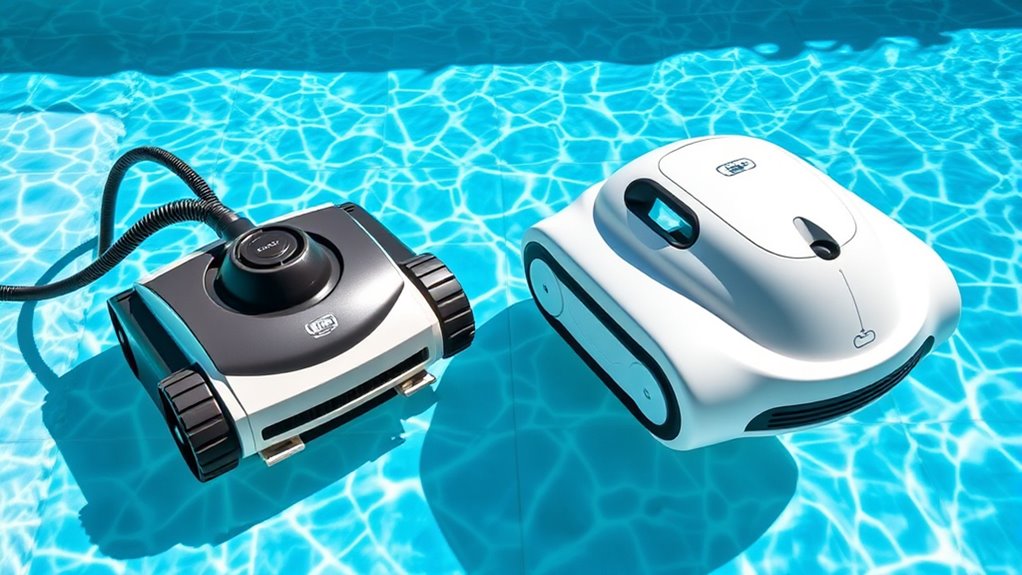
Robotic pool cleaners often simplify maintenance with their user-friendly interfaces and automatic features, making them easier to operate regularly. With minimal setup and straightforward controls, you won’t spend much time on upkeep. Their design also reduces the need for frequent manual cleaning or troubleshooting. When it comes to pricing strategies, robotic cleaners tend to be priced higher initially, but their ease of use can save you time and effort. Brand reputation plays a significant role, as trusted brands offer reliable performance and easier maintenance routines. Additionally, proper cleaning and maintenance, such as regular inspection and timely component replacement, can extend the lifespan and performance of these devices. Incorporating routine upkeep can further enhance their efficiency and longevity. Moreover, understanding local resources and support can help address any technical issues more effectively. Overall, robotic cleaners’ convenience and reputable brands make them a more hassle-free choice for ease of use and ongoing maintenance. Regularly checking manufacturer guidelines and user reviews can also provide valuable tips for optimal performance and troubleshooting.
Cleaning Performance and Effectiveness
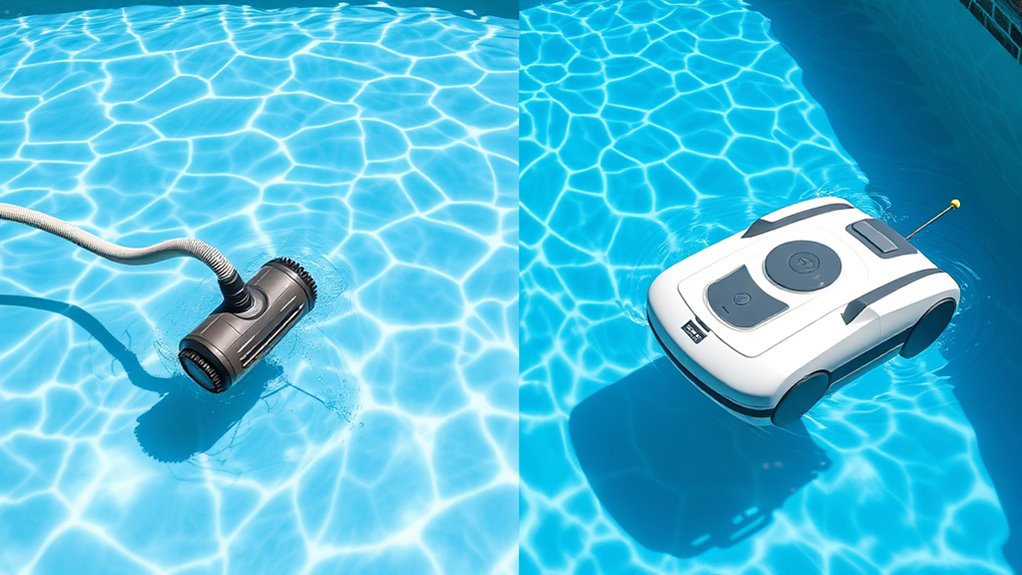
When it comes to cleaning performance, you’ll want to contemplate how well each cleaner covers your pool and removes dirt and debris. Robotic cleaners often excel at thorough coverage and picking up fine particles, while suction models might struggle with corners and stubborn grime. Deep cleaning capabilities also matter, especially if your pool needs more than just surface tidying. Additionally, some models incorporate advanced filtration technologies like HEPA filters or UV light to enhance overall cleaning effectiveness. For instance, filter technology can significantly influence how well a cleaner captures and retains various debris types. For example, tuning techniques such as improved motor efficiency or specialized brushes can significantly impact a cleaner’s ability to perform deep cleans and handle various debris types. Moreover, the design and aesthetic features of the cleaning units can influence ease of use and maintenance, further affecting cleaning performance. Incorporating smart navigation systems can also improve coverage and reduce missed spots, elevating the overall cleaning results.
Cleaning Coverage Scope
Suction pool cleaners excel at cleaning large areas quickly by attaching directly to the pool’s filtering system, but their coverage can be limited by the shape and obstacles in your pool. You might find spots missed due to complex layouts or tight corners. However, they’re effective at maintaining a clean pool when the filtering system works efficiently. Keep in mind, their battery life isn’t a concern since they rely on your pool’s power source. Additionally, understanding the filtration system in your pool can significantly impact the overall cleaning performance and effectiveness of suction cleaners. As technology advances, integrating automation can further enhance cleaning efficiency and coverage.
Dirt and Debris Removal
Suction pool cleaners are highly effective at removing dirt and debris from pool surfaces, especially larger particles like leaves and twigs. They excel at capturing debris through strong suction, reducing the need for frequent manual skimming. However, their effectiveness depends on regular filter replacement; a clogged filter can diminish cleaning power. You’ll also need to contemplate storage requirements, as suction cleaners often require space for their hoses and units. While they perform well on surface debris, they might miss finer dirt or algae in corners. Maintaining the filter and ensuring proper storage keeps your suction cleaner operating efficiently. Additionally, understanding gear maintenance and usage can help you keep your pool cleaner functioning optimally, extending its lifespan. Understanding anime culture and storytelling can help you choose the right cleaning tools for your pool area, ensuring a fun and relaxing environment. Overall, if you’re looking for straightforward debris removal, suction pool cleaners deliver reliable performance with proper upkeep.
Deep Cleaning Capabilities
While suction pool cleaners excel at removing surface debris, their deep cleaning capabilities vary. You might find that larger pool size demands more thorough cleaning, which not all models can provide. Here are three key factors to consider:
- Coverage of pool surfaces—a cleaner with better navigation ensures every corner is spotless, especially in bigger pools. Incorporating proper maintenance can also help keep the cleaner functioning at peak performance.
- Ability to handle chemical compatibility—some cleaners work better with pool chemicals, preventing damage and ensuring effective deep cleaning.
- Powerful suction and filtration—strong suction helps dislodge dirt stuck in cracks, improving overall cleanliness. Additionally, understanding the importance of cleaning performance can guide you in selecting a model that meets your pool’s needs. In addition, advancements in AI technology have led to smarter cleaning patterns and more efficient debris removal.
Your choice impacts not just surface appearance but the health of your pool, making deep cleaning capabilities a critical factor in selecting the right cleaner.
Energy Consumption and Efficiency
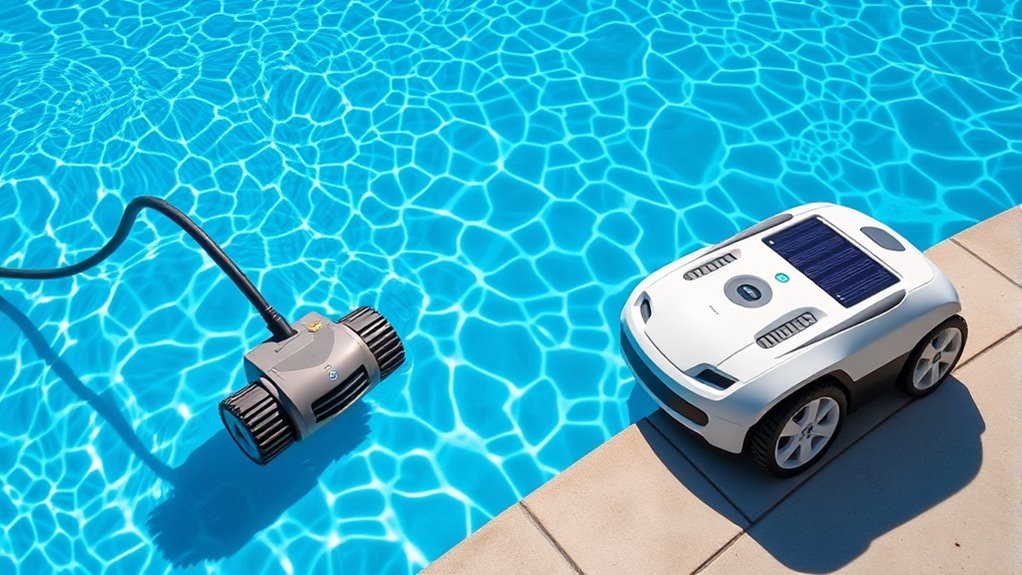
When comparing energy consumption, robotic pool cleaners generally outperform suction-based models by using less power and operating more efficiently. They are designed with energy efficiency in mind, which means lower power consumption without sacrificing cleaning performance. This results in reduced electricity bills and less environmental impact. To better understand, consider the following comparison:
| Feature | Robotic Pool Cleaners | Suction Pool Cleaners |
|---|---|---|
| Energy Efficiency | High | Moderate |
| Power Consumption | Low | Higher |
| Operating Cost | Lower | Higher |
| Power Usage Duration | Shorter | Longer |
| Environmental Impact | Lower | Higher |
Durability and Longevity
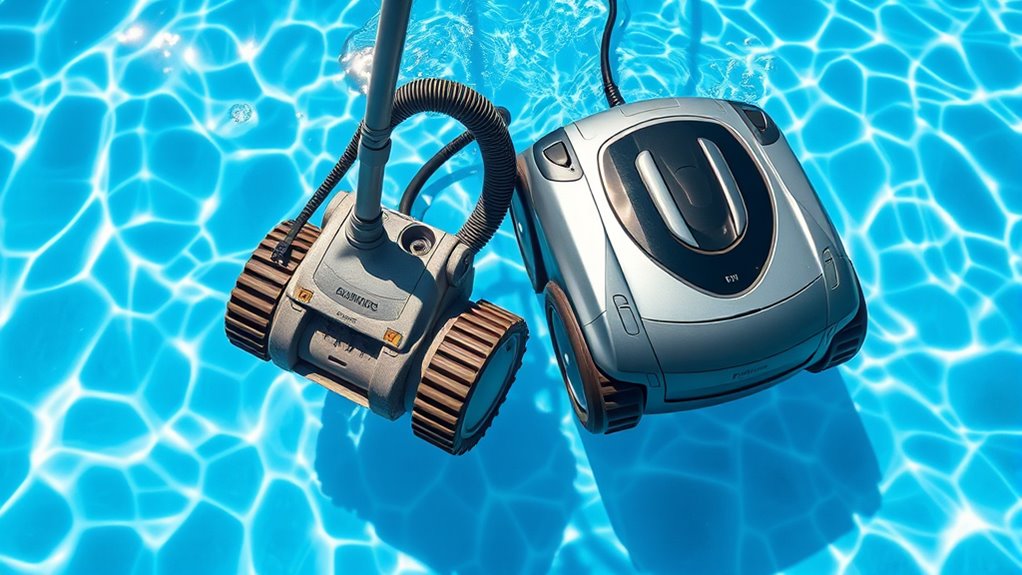
When choosing a pool cleaner, you want one that lasts through constant use. Consider how well the mechanical parts hold up, resist water damage, and withstand wear over time. These factors directly impact how long your cleaner will perform reliably.
Mechanical Components Durability
Mechanical components in pool cleaners must withstand frequent exposure to water, debris, and constant movement, making durability a crucial factor in their longevity. You want a cleaner that keeps working without constant repairs, so pay attention to how well the mechanical parts hold up over time. A well-designed aesthetic can hide wear and tear, giving you confidence in its longevity. The user interface also plays a role—if controls are sturdy and intuitive, you’re less likely to damage sensitive parts.
- You’ll feel peace of mind knowing your cleaner’s mechanical parts won’t fail prematurely.
- The aesthetic design ensures the device looks good and maintains integrity longer.
- A durable, user-friendly interface minimizes frustration and extends device life.
Water Resistance Capabilities
Durability isn’t just about sturdy mechanical parts; water resistance is essential for guaranteeing your pool cleaner keeps working over time. Whether you have a small or large pool, water resistance affects how well your cleaner withstands prolonged exposure to water, especially in varying water temperatures. In warmer water, materials may expand or degrade faster, so a cleaner with high water resistance will last longer. Conversely, in colder water, low-quality seals or inadequate waterproofing can lead to internal damage. Choosing a cleaner with robust water resistance capabilities means it can handle your pool size and water temperature fluctuations without compromising performance. This durability ensures you won’t need frequent replacements, making your investment more cost-effective and your cleaning routine more reliable.
Wear and Tear Resistance
Wear and tear resistance directly impacts how long your pool cleaner remains effective, especially with frequent use and exposure to harsh conditions. When evaluating durability, consider material durability and design resilience. A robust build ensures your cleaner withstands chlorine, debris, and constant movement without breaking down.
You should feel confident knowing that:
- Your cleaner won’t fall apart after months of use.
- Its parts stay intact, saving you money on replacements.
- It continues to perform reliably, keeping your pool spotless for years.
Choosing a model with high wear and tear resistance means investing in longevity. It guarantees your cleaner remains a dependable tool, giving you peace of mind and a cleaner pool season after season.
Ideal Pool Types and Situations
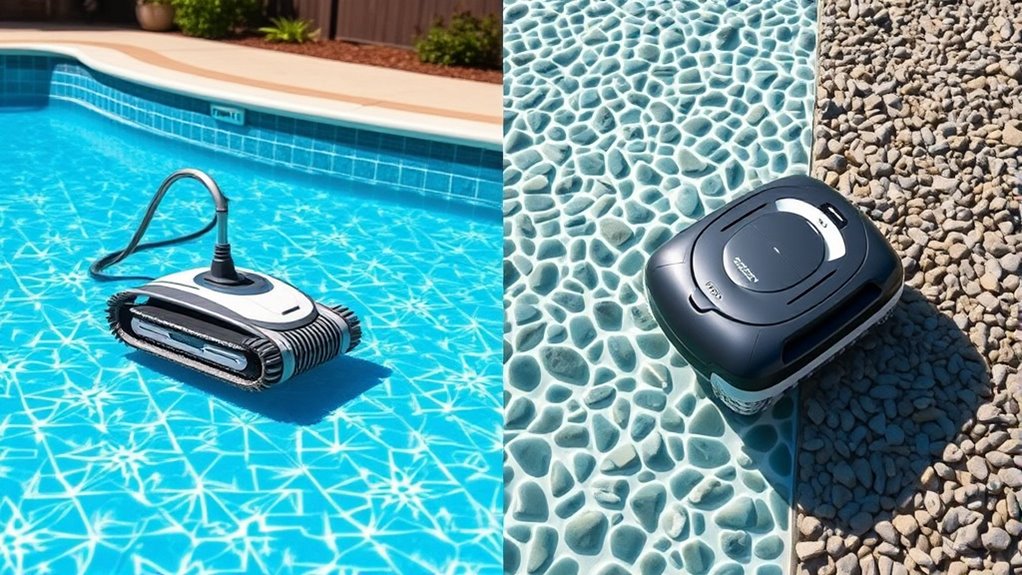
Choosing the right pool cleaner depends largely on your pool’s size, shape, and how often you use it. For large pools with complex shapes, robotic cleaners often excel because they navigate efficiently and clean thoroughly. Suction cleaners are ideal for smaller, simple pools, especially if you want a budget-friendly option. Consider your pool’s installation requirements: robotic cleaners usually need a power source nearby, while suction cleaners connect directly to your skimmer or suction port. Here’s a quick comparison:
| Pool Size & Shape | Best Cleaner Type |
|---|---|
| Small, simple | Suction Pool Cleaner |
| Large, complex | Robotic Pool Cleaner |
| Limited installation | Suction cleaner, minimal setup |
Frequently Asked Questions
Which Pool Cleaner Is Better for Above-Ground Pools?
Imagine spending hours manually cleaning your above-ground pool, feeling exhausted before even finishing. For larger pools, a robotic cleaner is often the better choice, covering more area efficiently with minimal effort. It handles pool size effortlessly without constant manual operation, saving you time and energy. Robotic pool cleaners are ideal for above-ground pools because they’re easy to set up, operate automatically, and keep your pool sparkling clean without the hassle.
How Often Should Pool Cleaners Be Serviced?
You should service your pool cleaner according to its maintenance schedule, typically every few months or as recommended by the manufacturer. Regular maintenance helps guarantee it runs efficiently and extends its lifespan. Keep in mind that service costs can vary, so budgeting for periodic check-ups or repairs is smart. By staying on top of maintenance, you’ll avoid costly repairs and keep your pool cleaner operating at its best all season long.
Can Robotic Cleaners Handle Algae Buildup?
Like a vigilant guardian, your robotic cleaner tackles algae buildup effectively, but it’s not a miracle worker. You need to focus on algae prevention by regularly balancing chemicals and brushing surfaces. While robotic cleaners can handle surface algae, they work best when combined with proper chemical balancing and routine maintenance. For stubborn algae, manual cleaning or chemical treatments might be necessary to keep your pool crystal clear and inviting.
Are There Eco-Friendly Suction Pool Cleaners Available?
You’re wondering if eco-friendly suction pool cleaners are available. The good news is, yes, there are options with sustainable design that minimize energy use and reduce environmental impact. Look for models with eco-friendly options that prioritize efficiency and eco-conscious materials. These cleaners help you maintain a clean pool while supporting sustainability, making it easier to care for your pool and the planet at the same time.
What Safety Features Do Robotic Pool Cleaners Have?
You’ll find that robotic pool cleaners come with essential safety features, like advanced robotic sensors that detect obstacles and prevent collisions. These sensors also help avoid accidents by stopping or changing direction if they encounter a person or pet in the pool. Such pool safety features guarantee you can enjoy your pool with peace of mind, knowing that the robotic cleaner is designed to operate safely and efficiently around your family.
Conclusion
So, whether you choose a suction pool cleaner or a robotic one, remember: the cheaper option might end up costing you more in headaches and manual labor. Ironically, spending a bit more could save you time, effort, and maybe even your sanity. In the end, it’s all about finding the perfect match for your pool and patience level—because sometimes, the most high-tech solution still can’t beat good old-fashioned elbow grease. Happy cleaning!
